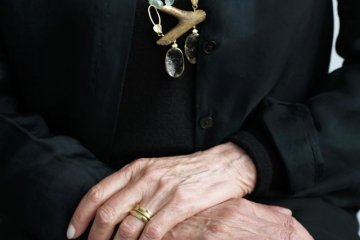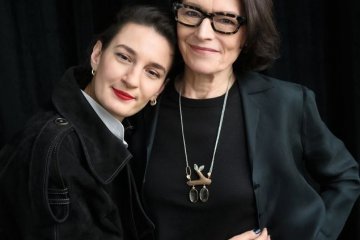Eva Eisler: Jewellery is an intimate architecture for the landscape of the human body
Designer, jewellery designer and sculptor Eva Eisler likes to take an almost architectural approach to her own jewellery making. She approaches each work and project with a new dose of curiosity that drives her on.
What gives you the most energy for your creative work? Where do you draw your strength?
Awakening your creativity and finding your unique inner voice will happen through the process of exploration. Finding ourselves, the source of energy and inspiration, realizing what is important to us, what are our desires, goals, dreams, motivations, challenges. I identify with Albert Einstein's quote that it is important not to stop questioning: "There is a reason for curiosity. One cannot help but wonder in awe at the mysteries of eternity, of life, or at the marvelous construction of reality. All we have to do is try to unravel that mystery a little each day."
What are the values or principles that guide your life and work?
I try not to do anything that doesn't have some deeper meaning or that already exists, and I try not to compromise in my work.
Which women in your environment do you admire? Which ones are an inspiration to you?
When I project in my mind a period of, say, the past four decades, and recall hundreds of memorable encounters, wherever they occurred, whether in Prague, New York, or while traveling across the world, and think of all the amazing, independent, wise, witty, generous, strong women, and enjoy the sense of mutual understanding and respect, and in many cases, long-lasting friendships, I know what an irreplaceable dimension my life is enriched by.
The feminine principle has always been seen as the basis of life, transformation and rebirth, containing a fundamental influence on the existence of a balance in our humanity, a balance between the feminine and masculine elements that encourages the acceleration of movement - of evolution. The concept of the woman-goddess has always been part of our consciousness. We have always known her as a virgin, a mother, a wise woman.We have known her depicted in statues, in mythology, in icons.The virgin is our child form, the mother is our nurturing force, and the psychic represents wisdom and inner freedom.
As Janja's professor, you accompanied her through her studies, you were an essential figure in the early days of her work. How did you perceive this role? What did you think was essential to pass on to Janja? Do you recall any milestone that particularly connected you during her studies?
Every student should understand the importance of personal responsibility for the communal environment and seek within themselves a true role for which they have the aptitude and strong motivation.Our job is to cultivate the environment and see ourselves as teammates. I understood this with Janja from the beginning as her innate talent. She went into everything with absolute commitment, independently and in her own way. She spared no creative energy, each new idea leading to countless others. Janja has a gift for storytelling and bases her work on fanciful tales. Her heroines are women who live life to the fullest and spread around them a positive animal energy, intellectually grounded.
In your opinion, what is the elementary characteristic of a piece of jewellery, its function, its meaning and significance?
Jewellery should reach into the innermost being of the wearer. When chosen appropriately, it is in harmony with a woman's personality, her style and her view of the world.
What do you see as the importance of jewellery?
I have never seen jewellery as a fashion accessory, it is always an independent art object that communicates something essential about its wearer. My motto is: "Jewellery is an intimate architecture for the landscape of the human body".
Do you have a favourite object that you use as a talisman or to give yourself courage, strength or inspiration?
I like to surround myself with things that have a story. I have a cabinet of curiosities at home, a collection of objects, mostly gifts from friends, even students, copies, but also a few originals of prehistoric artifacts I call Venus, often not easily identifiable. I pass by many times a day and always feast my eye, move something, or switch places for the objects to dialogue with each other.
How would you describe Janja's work?
In her thesis project, High Game, Janja explored the theme of the modern shaman, a warrior woman who demonstrates her distinctive femininity through her bravura weapons including a bow, sling, knife but also a dressing table. Wearing something made by Janja is for the perceptive something like wearing a talisman of one's faith.



